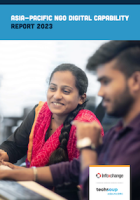
Digitalization can help reduce paperwork and improve productivity and efficiency. Photo credit: iStock/Wasan Tita.
The digital transformation journey consists of three elements, known as the 3Ps: people, process, and platform and technology.
This article is published in collaboration with Infoxchange.
Digital transformation—the process of making things easier via technology—has become a necessity for nongovernment organizations (NGOs) to navigate increasing societal, economic, and environmental challenges. Utilizing technology can greatly advance their ability to generate impact.
However, many nonprofits in the Asia–Pacific region are considered technologically “challenged.” In our 2023 APAC NGO Digital Capability Report, only 50% of workers in the NGO sector felt confident in their ability to use technology to perform their roles.
There is a direct correlation between organizations who have a technology plan and how confident they are in using technology to accelerate impact.
What is digital transformation?
Digital transformation is about making processes simpler so your team can make a bigger impact.
Many leaders in the nonprofit space are excited about technology like AI. But remember that AI is not a person but a technology.
The digital transformation journey must start with people. The process consists of three elements, known as the 3Ps (in this order):
- People,
- Process, and
- Platform and technology.
You need to start with your foundation in place and then explore how technology can make a real difference for your people.
Different paths to digital transformation
Over the past year, we have been delivering the Asia–Pacific NGO Digital Transformation Program, with support from Google.org and the Asian Development Bank (ADB). More than 47 NGOs were selected to take part in a coaching program.
To illustrate just how different digital transformation journeys can be, here are examples from these organizations. For some, it was akin to having collaborative access to one spreadsheet.
Zero Waste Malaysia and Reef Check Malaysia, both committed to protecting Malaysia’s environment and oceans, focused on improving their systems and data and migrating their resources and information to the cloud to reduce administration time for their people. These NGOs onboard thousands of volunteers to help their cause. However, their company policies, assets, and files were scattered across siloed systems. Collaboration entailed laborious back and forth emails. By focusing on improving systems and data, digital transformation enabled live collaboration in the same digital environment.
For others, the journey was more complex. Tuputoa, an organization in New Zealand helping young people gain leadership positions, introduced a process that focused on data infrastructure and building data stewardship.
While digitalization intends to simplify things over time, the reality is that it can increase workloads at the beginning. For TupuToa, staff (people) needed to understand the importance of data and why it is important to capture it, clean it, and enter it (process). The organization acknowledged that staff required extra time and support to participate in the journey. It allowed additional time in the week for learning and gave small incentives for staff to take part, like providing gift cards or lunch on the boss. These enabled staff to become empowered with data. They now know how many lives they have impacted through their work.
We helped guide the digital transformation strategy of the Alannah & Madeline Foundation, an Australian charity that works to protect the safety of children online. The goal was to deliver one learning platform for all the foundation’s programs. Due to the nature of funding cycles, NGOs are often forced into project siloed decision-making. An organization-wide strategy focusing on platforms led to the development of a universal learning portal that will provide stronger visibility for learning outcomes. The foundation would also tap national expertise to deliver a program for teachers, students, and children to learn in a way that is most appropriate for them.
The Deli, which provides services to victims of trauma in Australia, was struggling to respond to the high level of demand for women and children support services. Its work was hindered by siloed data and large volumes of paper client records, emails, and reporting requirements. Streamlining internal processes on the cloud improved information collaboration and secure data management. The Deli was able to reduce the support wait time of their beneficiaries by an estimated 87%.
Developing a strategy and program
There are 10 key steps to developing a digital transformation program.

Step 1: Where are you today as an organization?
It is important to ask why your NGO exist and what are your strategic goals and potential growth opportunities.
Step 2: The why.
Why do you need to digitally transform your processes?
If you want to provide services to vulnerable people in urgent need of assistance and you are not clear on your objectives and how to achieve them, it becomes far more difficult to maintain momentum through the journey and support beneficiaries.
Step 3: Evaluate your capabilities.
Assess your capabilities for digital transformation, and identify a good target point to get to in the future. If you do not know where you are today, you might be shooting for Saturn when your target is the Moon.
Step 4: Getting executive buy-in.
It is critical that you get the support of executives, the board, and lead management. People are likely to adopt initiatives that help them with their everyday life, so cascade information to your staff when you get them involved.
Step 5: Identify the course of action.
This is where you identify your 3 Ps: people, process, and platforms.
For example, to improve fundraising management capability, a “people” course of action could be to appoint a person dedicated to fundraising support. The “process” could be to enhance the donation process by enabling online donations to cater to online donation management, and the “platform” could be the implementation of a donor management system.
Step 6: Formulate and prioritize initiatives.
Now that you know your key challenges and gaps, you can proceed with creating your digital initiatives. Prioritize the initiatives based on their impact and estimated effort.
Step 7: Develop a road map and plan.
Formulate a plan so you can determine the sequence and delivery schedule of initiatives. Review it with a critical eye—is it realistic? Are the benefits of the actions enough to justify the effort and cost? Remember that you cannot tackle everything all at once. A realistic plan takes into account the resources and budget required.
Step 8: Find partners to accompany the organization in the journey.
Many nonprofits do not have the internal expertise to execute on the plan. One effective way to relieve the workload is using external resources like volunteers, consultants, or service providers.
Step 9: Communicate and engage with stakeholders.
Communicating with your staff about the journey will motivate them to participate. Make it clear how the new steps will make their everyday work easier and subsequently help them generate more impact for the communities they serve.
Step 10: Start executing.
You are ready to start your journey. Remember that there is no “perfect” structure for a digital transformation strategy road map. It is about choosing a structure that is right for your organization.
Digital transformation may not always go as planned. You will need to manage the ever-changing barriers. The more you get things right, the more value you will get out of the process, and the more impact you will have for the causes you support.
It is not about your organization’s size, how much you spend, or having the smartest CIO in the world. It is about understanding where your journey starts, where it is going, and how you will support your people to get there. This is where you will see the greatest difference.
You can watch all recordings of the Asia–Pacific Digital Transformation Webinar Program covering AI, data, cloud collaboration, digital marketing, and cybersecurity here.

Infoxchange
Infoxchange is a not-for-profit social enterprise that has been delivering social justice for 35 years through the smart and creative use of technology. We work with community, government, and corporate partners to solve issues around homelessness, family violence, mental health and disability, and climate change, and support First Nations communities, women, youth, and families.


